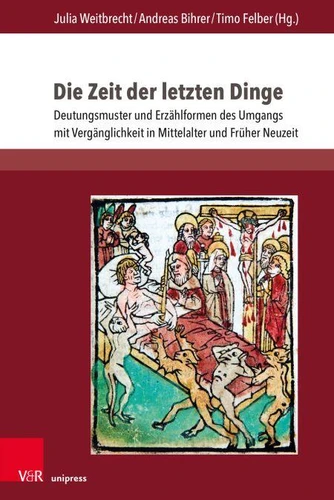Die Zeit der letzten Dinge. Deutungsmuster und Erzählformen des Umgangs mit Vergänglichkeit in Mittelalter und Früher Neuzeit
Par : , , , ,Formats :
Disponible dans votre compte client Decitre ou Furet du Nord dès validation de votre commande. Le format PDF est :
- Compatible avec une lecture sur My Vivlio (smartphone, tablette, ordinateur)
- Compatible avec une lecture sur liseuses Vivlio
- Pour les liseuses autres que Vivlio, vous devez utiliser le logiciel Adobe Digital Edition. Non compatible avec la lecture sur les liseuses Kindle, Remarkable et Sony
 , qui est-ce ?
, qui est-ce ?Notre partenaire de plateforme de lecture numérique où vous retrouverez l'ensemble de vos ebooks gratuitement
Pour en savoir plus sur nos ebooks, consultez notre aide en ligne ici
- Nombre de pages345
- FormatPDF
- ISBN978-3-8470-1097-5
- EAN9783847010975
- Date de parution17/02/2020
- Protection num.pas de protection
- Taille8 Mo
- Infos supplémentairespdf
- ÉditeurV&R Unipress
Résumé
Die Endlichkeit menschlicher Existenz ist anthropologisch konstant, doch sind die Formen ihrer Wahrnehmung historisch und kulturell höchst variabel. Dieser Band untersucht verschiedene Umgangsformen mit dem Tod in Mittelalter und Früher Neuzeit. In der Konfrontation mit der eigenen Sterblichkeit werden in vielfältigen Bewältigungsstrategien wie Erzählungen, Bildern, Symbolen und Ritualen für das mittelalterliche Denken grundlegende Aspekte von Zeitlichkeit reflektiert, die sich als Phänomene von Heterochronie beschreiben lassen.
Das Spektrum der Beiträge eröffnet so einen Zugang zu einem differenzierten historischen Verständnis der vielfältigen Austauschphänomene zwischen Diesseits und Jenseits wie auch der Integration divergenter Zeithorizonte in die mittelalterliche Lebenspraxis. The finite nature of human existence is anthropologically constant. However, the characteristics of its perception varies extremely throughout history and within different cultures.
This volume analyses different ways to cope with death in the Middle Ages and Early Modern times. In the confrontation with one's own mortality various coping strategies like narratives, pictures, symbols and rituals reflect fundamental aspects of medieval thinking that can be described as phenomena of heterochrony. Thus, the various contributions enable an access to a sophisticated historical understanding of the various interchangeable phenomena between this life and the hereafter as well as the integration of divergent time horizons in the medieval life practice.
Das Spektrum der Beiträge eröffnet so einen Zugang zu einem differenzierten historischen Verständnis der vielfältigen Austauschphänomene zwischen Diesseits und Jenseits wie auch der Integration divergenter Zeithorizonte in die mittelalterliche Lebenspraxis. The finite nature of human existence is anthropologically constant. However, the characteristics of its perception varies extremely throughout history and within different cultures.
This volume analyses different ways to cope with death in the Middle Ages and Early Modern times. In the confrontation with one's own mortality various coping strategies like narratives, pictures, symbols and rituals reflect fundamental aspects of medieval thinking that can be described as phenomena of heterochrony. Thus, the various contributions enable an access to a sophisticated historical understanding of the various interchangeable phenomena between this life and the hereafter as well as the integration of divergent time horizons in the medieval life practice.
Die Endlichkeit menschlicher Existenz ist anthropologisch konstant, doch sind die Formen ihrer Wahrnehmung historisch und kulturell höchst variabel. Dieser Band untersucht verschiedene Umgangsformen mit dem Tod in Mittelalter und Früher Neuzeit. In der Konfrontation mit der eigenen Sterblichkeit werden in vielfältigen Bewältigungsstrategien wie Erzählungen, Bildern, Symbolen und Ritualen für das mittelalterliche Denken grundlegende Aspekte von Zeitlichkeit reflektiert, die sich als Phänomene von Heterochronie beschreiben lassen.
Das Spektrum der Beiträge eröffnet so einen Zugang zu einem differenzierten historischen Verständnis der vielfältigen Austauschphänomene zwischen Diesseits und Jenseits wie auch der Integration divergenter Zeithorizonte in die mittelalterliche Lebenspraxis. The finite nature of human existence is anthropologically constant. However, the characteristics of its perception varies extremely throughout history and within different cultures.
This volume analyses different ways to cope with death in the Middle Ages and Early Modern times. In the confrontation with one's own mortality various coping strategies like narratives, pictures, symbols and rituals reflect fundamental aspects of medieval thinking that can be described as phenomena of heterochrony. Thus, the various contributions enable an access to a sophisticated historical understanding of the various interchangeable phenomena between this life and the hereafter as well as the integration of divergent time horizons in the medieval life practice.
Das Spektrum der Beiträge eröffnet so einen Zugang zu einem differenzierten historischen Verständnis der vielfältigen Austauschphänomene zwischen Diesseits und Jenseits wie auch der Integration divergenter Zeithorizonte in die mittelalterliche Lebenspraxis. The finite nature of human existence is anthropologically constant. However, the characteristics of its perception varies extremely throughout history and within different cultures.
This volume analyses different ways to cope with death in the Middle Ages and Early Modern times. In the confrontation with one's own mortality various coping strategies like narratives, pictures, symbols and rituals reflect fundamental aspects of medieval thinking that can be described as phenomena of heterochrony. Thus, the various contributions enable an access to a sophisticated historical understanding of the various interchangeable phenomena between this life and the hereafter as well as the integration of divergent time horizons in the medieval life practice.



